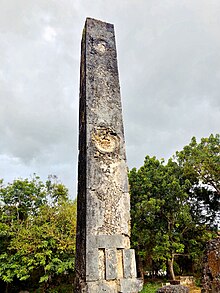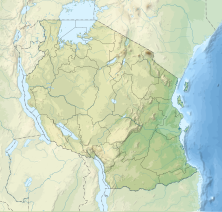 Pillar tomb at Tongoni | |
| Location | Tanga Region, Pangani District, Tongoni ward, |
|---|---|
| Coordinates | 5°12′57″S 39°03′50″E / 5.21581256°S 39.0638125°E |
| Type | Settlement |
| History | |
| Material | Coral rag |
| Founded | 14th century CE |
| Abandoned | 17th century CE |
| Cultures | Swahili |
| Site notes | |
| Excavation dates | 1981 |
| Archaeologists | Richard Gramly |
| Condition | Protected |
| Ownership | Tanzanian Government |
| Management | Antiquities Division under the Ministry of Natural Resources and Tourism[1] |
| Architecture | |
| Architectural styles | Swahili & Islamic |
| Official name | Tongoni Historic Site |
| Type | Cultural |
| Protected | |
The Tongoni Ruins (Magofu ya kale ya Tongoni in Swahili) are a 15th century Swahili ruins of a mosque and forty tombs located in Tongoni ward in Tanga District inside Tanga Region of Tanzania. The largest and possibly most significant Swahili site in Tanzania is Tongoni, which is located 25 km north of the Pangani River. Overlooking Mtangata Bay, about forty standing tombs and a Friday mosque of the "northern" style occupy a third of a hectare. People from the area continue to worship there spiritually. They bury their departed family members to the south of the historic tombs.[2] The area was a different place four to five centuries ago. Contrary to its almost unnoticed presence today, it was a prosperous and a respected Swahili trading centre during the 15th century. Most of the ruins are still not yet been uncovered.[3] The site is a registered National Historic Site.[4]
- ^ "Antiquities Division". Retrieved 21 Jul 2022.
- ^ Kirkman, J. S. "The Mediaeval History of the Coast of Tanganyika. By GSP Freeman-Grenville. 8× 11½. Pp. 219+ 6 pl.+ 3 maps. Oxford, by arrangement with Akademie-Verlag GmbH, Berlin, 1962. 50s." The Antiquaries Journal 43.2 (1963): 320-321.
- ^ Mabulla, Audax Z. P. (2000). "Strategy for Cultural Heritage Management (CHM) in Africa: A Case Study". The African Archaeological Review. 17 (4): 211–233. doi:10.1023/A:1006728309962. JSTOR 25130707. S2CID 142911818.
- ^ "Antiquities Sites" (PDF). Retrieved 21 Jul 2022.







